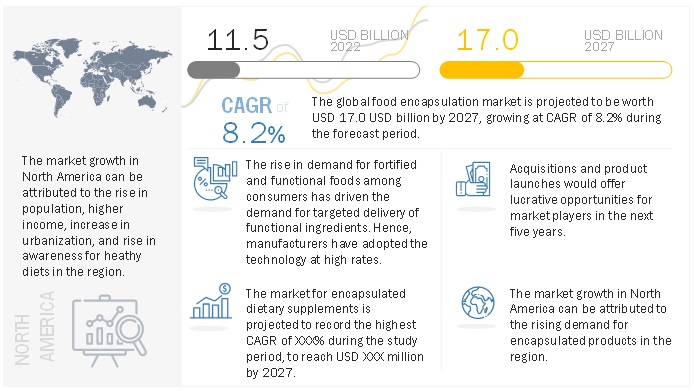Food Encapsulation Market: Growth Opportunities and Recent Developments
The global food encapsulation market was valued at USD 11.5 billion in 2022 and is projected to reach USD 17.0 billion by 2027, growing at a CAGR of 8.2% during the study period. The market for encapsulation is growing globally at a significant pace due to its numerous applications and multiple advantages over other technologies. Some of the major advantages of encapsulation are that it helps provide enhanced stability and bioavailability to the bioactive ingredients, increases the shelf life of food products, and maintains the taste and flavor for a longer period of time. Encapsulation is increasingly used in various industrial areas, such as nutraceuticals and food and beverages.

Download PDF Brocure: https://www.marketsandmarkets.com/pdfdownloadNew.asp?id=68
Vitamins and minerals is projected to grow in the food encapsulation market because of usage in superfoods for boosting brain and bone health
Consumers’ increasing attention to health and prevention, greater customized nutrition needs for different segments of the population, rising healthcare costs, search for alternatives to cure specific problems, and rising consumer awareness regarding the severity of chronic diseases drive the need for vitamins and minerals.
Vitamins are functional ingredients used in food products due to their specific nutritional properties. They are classified as fat-soluble and water-soluble vitamins. Fat-soluble vitamins contain vitamins A, D, E, and K. Vitamins B and C form a part of water-soluble vitamins. When added as a food ingredient, it is vital to target and control the release of these vitamins. This drives the need for their encapsulation. According to an article by Nutraingredients in 2019, over 40% of the vitamins consumed in the food industry are encapsulated. The encapsulation of vitamins is necessary to enclose vitamin molecules in a stable shell to prevent oxidation, preserve the nutrients, and prevent the products from deteriorating for a longer period of time.
Robotic Technology in Food Encapsulation is One of the Major Trends
Robots enhance the process of packaging nutraceutical supplements by being time-efficient and accurate. They increase the shelf life of nutraceutical ingredient products and help them comply with regulatory guidelines by reducing the risk of contamination. Furthermore, the recent increase in demand for nutritional supplements requires large-scale production, increasing the demand for robots to optimize production facilities.
Analyzing machine performance, gathering data, and troubleshooting in advance are the key robotics trends in the nutraceutical ingredients market projected to increase technology adoption in the industry. COBOTs are primarily used in the nutraceutical industry for such applications. According to TransAutomation Technologies, the labor expenditures of three people each day can be offset by a single robot that can perform one function for 24 hours per day. This helped several pharmaceutical and nutritional supplement manufacturers increase productivity, reducing their need for human labor and the challenges and costs that go along with it. Collaborative robots enable humans and robots to work together effectively in open or uncaged environments. Through collaborative robots, a human operator and robot can be engaged together in the same process, or the operator can simultaneously manage other tasks that a person might better solve.
Request for Sample Pages: https://www.marketsandmarkets.com/requestsampleNew.asp?id=68
Asia Pacific is to grow by 9.0% CAGR during the forecast period.
The Asia-Pacific region has grown in the food encapsulation market recently. The Asia Pacific market is projected to be the fastest-growing market for food encapsulation over the next five years. Encapsulation helps in taste and flavor masking and enhances the shelf life of these products. Product manufacturers in this region face challenges due to the high atmospheric temperature, which affects the stability of bioactive ingredients. This challenge can also be overcome by using encapsulation technology.



